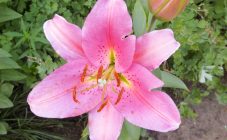Content:
Lilies are flowering plants with attractive shapes and a variety of bright colors. Reproduction of this culture is possible in several ways: scales, bulbs or cuttings. Any breeding method used will not cause much trouble if you first familiarize yourself with all the rules and features. Reproduction of lilies by scales in the summer is the topic of today's article.
Breeding methods for lilies in the open field
Lilies can be propagated in several vegetative ways, it is enough to familiarize yourself with the main features and rules for their implementation.
You can propagate any varieties of lilies in the following ways:
- scales are used to propagate varietal lilies;
- by dividing the nest of the bulbs;
- cuttings of leaves and stems;
- using baby bulbs.
Rapid cultivation is ensured by obtaining the bulbs from the stem bulbs.
The main task of all the above methods is to obtain new bulbs from different underground and aboveground parts of the plant.
The simplest of these is dividing the nest of bulbs into small children. The separation process is an integral part of bush care. Otherwise, new bulbs will start replacing the old ones, and as a result, the normal growth of lilies will stop. The most suitable time for the procedure is the beginning of autumn; it is strongly discouraged to do this in spring. After separation, each child must be planted in the ground, in a new place. In the first year of its development, the plant will not bloom, it needs attention and care.
According to experienced agronomists, the fastest breeding method is the rooting of scales. In addition, more than 150 new plants can be obtained from one plant thanks to this method of propagation. It is possible to separate parts from the mother bulb throughout the year, but it is better to do this after the autumn digging or with the onset of spring. Winter is not a very good time. The separated onion fragments are washed under running water, disinfected with special solutions (they should not affect the germination of the planting material) and dried. When planting, the depth of the hole should be 2/3 of the length of the flake.
Another common method is to get the bulbs from the stems. They must be harvested shortly after flowering, during which time they are easily separated. The collected planting material should be stored in a dry, cool, dark place until the roots appear. Next, the bulbs are planted in open, light and fertile soil. The depth of burial should be approximately 2-3 cm, the interval between them is at least 5 cm. The developing plant does not need special care, regular watering, loosening and the introduction of mineral / organic fertilizers are enough.
Lilies can also propagate by cutting leaves and stems. The method is used when there is a shortage of other planting material. The method must be implemented before the formation of new buds; it is necessary to divide the stem into several parts. The resulting cuttings are deepened into the soil to the upper leaves.After planting, the cuttings must be covered with agrofibre or plastic wrap, after strengthening, the plant is transferred to open soil.
Features of the reproduction of lilies by scales
Reproduction of lilies by scales with the onset of spring is perhaps the most popular method, since it allows you to get high-quality planting material. Using this method, a whole flower bed can be grown from one adult plant.
Despite the simplicity of execution, the procedure has its own subtleties, which must be taken into account.
Features:
This propagation method can be applied to almost all plants. In addition, planting material can be prepared at any time of the year.
If the scales were detached in the spring, then they should be immediately planted in open soil. If in the fall, then you need to treat them with a special disinfecting and growth-stimulating solution and put them on preservation until spring.
Step-by-step instruction:
- Gently push the soil apart to avoid damaging the root system. Remove the onion to the surface;
- From the bottom of the mother bulb, it is necessary to separate the desired number of scales (the optimal amount is 5-6);
- The break point on the mother bulb must be treated with a disinfectant solution, for example, manganese or crushed charcoal;
- Place the mother bulb in its original place, sprinkle with soil;
- The separated flakes must be washed under running water and treated with a disinfectant;
- Put prepared scales in a bag and tie tightly.
During the first six to eight weeks, the optimum temperature for storing planting material is + 22-25 degrees, for the next months it is desirable to lower the temperature to +17 degrees. The rest of the time, the flakes should be stored in a cool place.
The depth of occurrence should not exceed 4 cm, otherwise seedlings may simply not appear. The interval between the holes should be 5-6 cm, and the row spacing should be 20-25 cm. After planting, the soil must be watered, and then mulched using rotted humus or peat. In the near future, the plant does not need special care, it is enough to provide regular watering, weeding from weeds, loosening and fertilizing.
Lilies are amazing plants that deserve the attention of agronomists. If you propagate these plants correctly, they will delight you with their beautiful flowers and become a good garden decoration.














